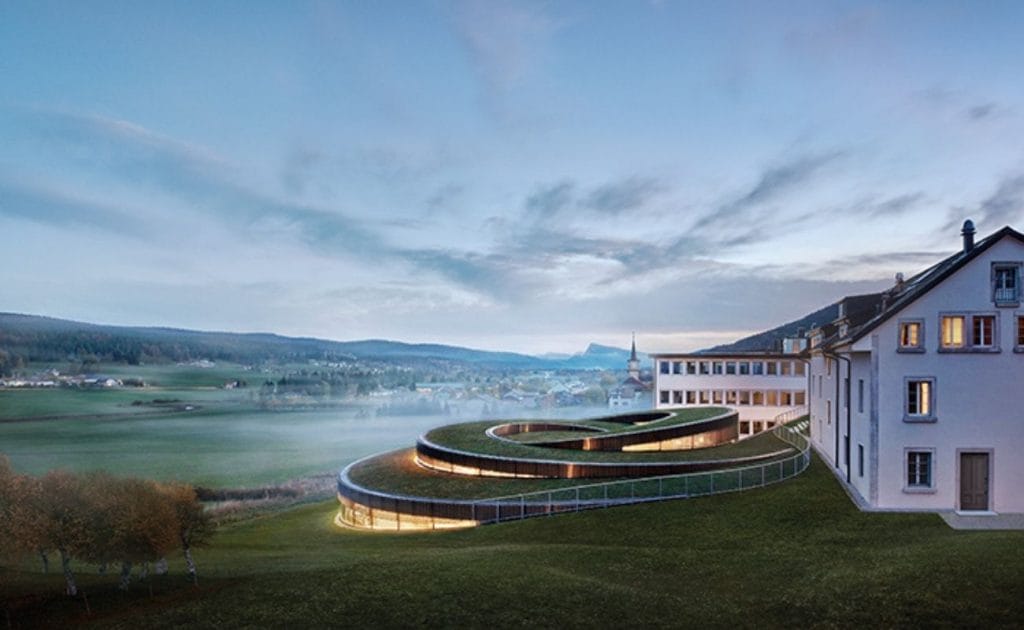A few years ago, The Peak visited the original Audemars Piguet museum during a trip to its facilities in Les Brassus, Switzerland, where we were impressed by the historical timepieces reflecting the brand’s now 145-year legacy.
Located in the historic building where Jules Audemars and Edward Piguet first started their workshop in 1875, the showcased pieces included pocket watches dating back to the 1870s, a 1995 ‘Star Wheel’ cushion-shaped minute repeater with a wandering-hours display, and the brand’s first self-winding tourbillon wristwatch in a slim rectangular case.
Given the rich historicity of these pieces, it was obvious that a display space more expansive than various small rooms in the historical house was needed. The solution: the brand-new Musee Atelier Audemars Piguet, a stunning, spiral-shaped glass pavilion that is now officially opened. It sits right next to other existing facilities within the Swiss Vallee de Joux in the Jura Mountains.

Sebastian Vivas is Audemars Piguet’s Heritage and Museum Director
Covering a space of 2,500 sq m, the pavilion is made from curved structural glass covered with a brass lattice screen that helps regulate light and temperature. Harmoniously integrated into the natural gradient of the land, the circular building designed by BIG (Bjarke Ingels Group) allows visitors to embark on a continuous, linear spatial experience that goes from the 19th to the 21st centuries. And, reminiscent of the back-and-forth circular motion of a hairspring, visitors move in a curved path towards the centre of the spiral before going in the opposite direction.
According to the brand’s notes, German museum designer Atelier Bruckner imagined the composition of the exhibition as a musical score, with crescendos, high points and contemplative moments. Interludes, including sculptures, automata, kinetic installations and mock-ups of intricate mechanical movements, give life and rhythm to various aspects of horological technique and design.
The Musee Atelier – museum workshop in French – also houses the Grand Complications and Metiers d’Art workshops, giving visitors the chance to see the brand’s top watchmakers and artisans in action as well as try their hand at some of these traditional techniques.
Sebastian Vivas, Audemars Piguet’s Heritage and Museum Director, says: “We have aimed to express the most important facets of our brand – its history, free spirit, craftsmanship, passion for mechanics and design and, of course, its people – in the most exciting and interesting ways. We hope everyone, from the most experienced watch collectors to amateurs of architecture and tourists discovering our beautiful region, finds something that will move them. We also hope that they will go ‘wow’ a few times and experience something surprising and memorable.”
We take you through the Musee Atelier’s highlights.
The restoration workshop
The museum also features horology inspired art – like this multimedia installation from Alexandre Joly
The museum is also a showcase of Audemars Piguet’s horological savoir-faire
A timepiece showcase within the museum
01 Exceptional watches
Vivas and his team selected more than 300 watches to tell the story of more than 200 years of watchmaking in the Swiss Jura. According to Vivas, the watches include “highly complicated watches, masterpieces of design, high-jewellery brooches and necklaces, as well as several world firsts”.
“Selecting the watches was a long process for the heritage team. We chose the creme de la creme, but they also had to illustrate the messages and stories we wanted to convey. After years of adjustments and re-adjustments, the heritage team spent the last few days in a small isolated hotel, sticking small pictures of each watch on the walls, reworking the narrative and putting the final touches on the selection,” he says.
02 Showcase of savoir-faire
To establish the space as “a living museum” , the Grand Complications and Metiers d’Art workshops are situated at its heart. Asked why the two were chosen, Vivas puts it beautifully: “The two workshops are dedicated to the inside and the outside of the watches. The most complex movements are created in the Grand Complications workshop, where a watchmaker can dedicate up to eight months for a single watch. The most complex cases are created in the Metier d’Art workshop, where it takes up to one year to produce one high jewellery watch. They are situated here because their craftspeople produce the timepieces of today and tomorrow.”
03 Beyond watchmaking
To be relevant today, a brand has to be about more than its products. The Musee Atelier also houses the Audemars Piguet Foundation, which contributes to forest conservation. With cultural and artistic engagement also a priority, the museum further functions as an exhibition venue for travelling artworks by the brand’s commissioned artists. Since 2012, the brand has commissioned artists such as Dan Holdsworth, Quayola and Alexandre Joly to present interpretations of its origins in the Vallee de Joux. Works by these artists, including Joly’s multimedia installation Subliminal Moving Shapes, will be displayed at the Musee Atelier.
04 Continuing history
At the beginning, we mentioned that the historical building used to house the original museum. With such a hallowed history, it remains an integral part of the Audemars Piguet story. It is connected to the new museum workshop and has been renovated to more closely reflect its past. For example, new wall claddings include historical woodwork from the valley. “Some were saved from old farms,” says Vivas.
The restored building now houses the register room, the archives, the heritage department and the Restoration Atelier. We got to see the restoration workshop when we visited in 2018 and it is spectacular. It has records on the brand’s oldest timepieces and the watchmakers here can use these specifications to create out-of-production components – such as minute-repeater gongs – by hand. Says Vivas: “They perpetuate the traditional know-how to make sure future generations will always be able to repair the mechanical marvels made in the Vallee de Joux.”
This story first appeared in The Peak Singapore



